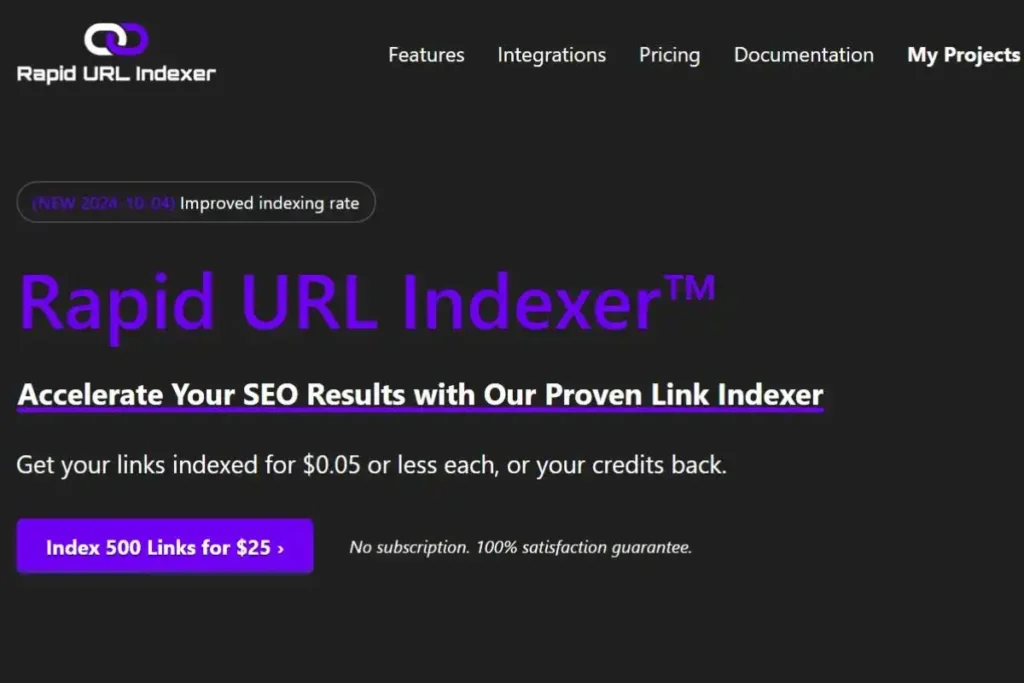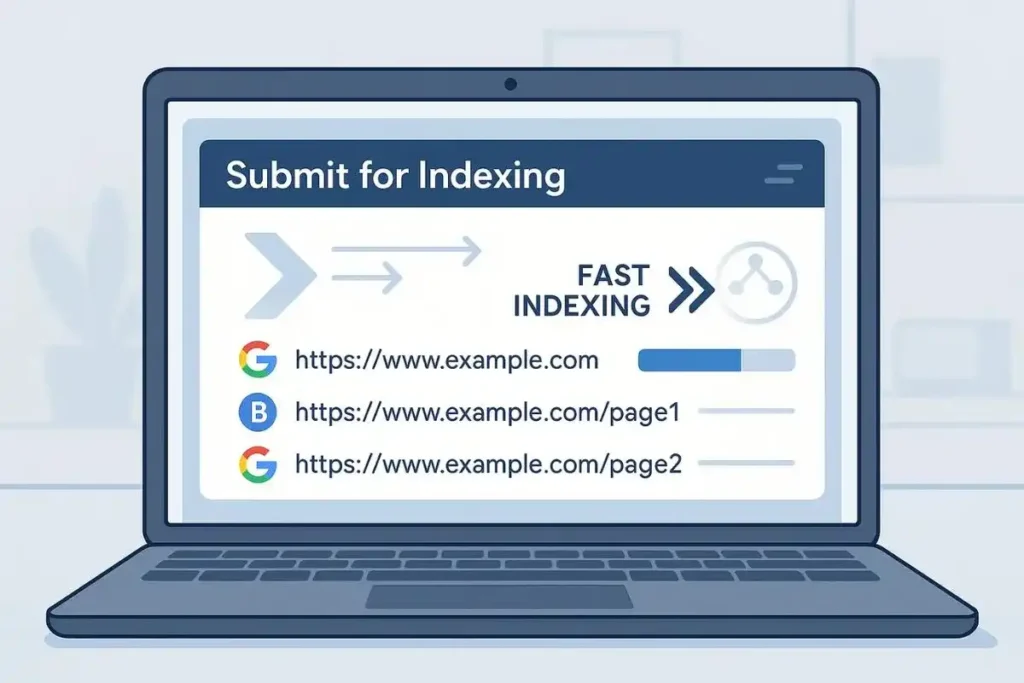
You’ve spent hours writing, editing, and perfecting your latest blog post or landing page. You hit “publish,” full of hope and expectation. But then… crickets. Days pass, and your content still hasn’t appeared on Google. You start to wonder, “Did I do something wrong? Why is my website not getting indexed?” This annoying delay can make all your effort feel wasted and leave you questioning how to get your content noticed faster. You’re not alone. Many website owners, bloggers, and digital marketers face this exact problem. Fortunately, there’s a powerful tool that can solve it quickly and efficiently: the Rapid URL Indexer.
What Is the Rapid URL Indexer and How It Works
Definition and Purpose
The Rapid URL Indexer is a specialized SEO tool designed to help you get your web pages indexed faster by search engines like Google and Bing. Instead of waiting days or even weeks for your content to be crawled and indexed naturally, this tool sends direct signals to search engines, speeding up the process.
How Rapid URL Indexer Works
- You submit the URL of your new content.
- The tool notifies multiple search engines or uses APIs to inform them about your content.
- Search engine bots prioritize crawling and indexing your submitted URLs.
The process is simple, fast, and doesn’t require deep technical knowledge. Whether you’re a beginner or an advanced SEO expert, Rapid URL Indexer makes content visibility easier.
Behind the Scenes – Technical Process
Rapid URL Indexer often uses search engine APIs, ping services, and proprietary algorithms to notify crawlers like Googlebot. These bots then visit your site, scan the new page, and add it to the search engine’s index. Some advanced tools even integrate with Google Search Console for direct URL submission.
Why Is Rapid Indexing Important for SEO?
Speed Equals Visibility
In the world of SEO, timing is everything. Getting your content indexed quickly can mean the difference between ranking on the first page or getting buried under competitors. Fast indexing ensures:
- Your content appears in search results sooner.
- You gain traffic during trending topics or time-sensitive events.
- Search engines recognize and prioritize your updates.
Problems with Natural Indexing
Natural indexing depends on many factors, and it often comes with delays. These delays can be caused by:
- Crawl budget limitations
- Lack of backlinks to the new page
- Improper internal linking
- Technical errors such as noindex tags or duplicate content
When your page is not indexed, it doesn’t exist in the eyes of search engines.
Comparison of Natural Indexing vs. Rapid URL Indexer
| Feature | Natural Indexing | Rapid URL Indexer |
|---|---|---|
| Indexing Time | Days to weeks | Hours to 2–3 days |
| Manual Control | Limited | Full control |
| Optimized for SEO | No | Yes |
| Works for New Sites | Slow | Faster |
| Alerts Search Engines Instantly | No | Yes |
Best Practices for Using Rapid URL Indexer
When and How Often to Use
It’s best to use Rapid URL Indexer when you:
- Publish new blog posts
- Add new landing or product pages
- Update old content with significant changes
Avoid submitting the same URLs repeatedly, as that might be seen as spammy behavior. Also, only use the tool for content that you want indexed publicly.
Combine With Technical SEO
To maximize the impact of rapid indexing, it’s important to:
- Submit an XML sitemap to Google and Bing
- Use Google Search Console to monitor indexing status
- Optimize your site for mobile and fast loading
- Fix broken links and ensure clear site structure
Use With Other SEO Tools
Rapid URL Indexer works even better when used alongside other SEO tools:
- Keyword research tools like Ahrefs, Ubersuggest, or Semrush
- On-page SEO tools to check content optimization
- Backlink analysis tools to boost page authority
Combining these elements can elevate your content’s performance.
Boosting Website Ranking with Rapid Indexer and SEO Tactics

Related: SEO Basics: A Beginner’s Guide to Getting Found on Google
Content Optimization Tips
To improve your chances of ranking high after indexing:
- Use focus keywords naturally in titles and headers
- Incorporate LSI keywords such as “submit URL to Google,” “ping search engines,” and “Googlebot”
- Write high-quality, original content that solves user problems
- Structure your content using headings, bullet points, and internal links
Backlinks Still Matter
While Rapid URL Indexer can get your content seen faster, backlinks are still a powerful ranking factor. You should:
- Build links from niche-relevant blogs and websites
- Submit guest posts
- List your site in high-quality directories
These links boost your website’s authority and credibility with Google.
Related: Backlink Building: 10 Proven Techniques for SEO Success
Indexing Tools vs. Backlinking in SEO
| Metric | Rapid URL Indexer | Backlink Building |
| Indexing Speed | Fast | Slow |
| Boosts PageRank | No | Yes |
| Ideal For | New pages | Existing content |
| Cost-Effective | Yes | Often costly |
Real-Life Use Cases and Success Stories
A Blogger’s Journey
I once published a seasonal blog post about holiday gift ideas. Despite optimizing everything, it didn’t appear in search results for days. After using Rapid URL Indexer, it showed up on Google the next morning and received over 500 visits in 48 hours. That experience made me a loyal user.
Small Business Impact
Maria, an Etsy shop owner, used the Rapid URL Indexer to get her product pages indexed. Within a week, she saw a spike in organic visits and two of her new products sold out. She credits the tool for giving her small business the visibility it needed.
E-commerce Indexing Strategy
For e-commerce store owners, rapid indexing is a game changer. With hundreds of new or seasonal product pages, waiting for Google’s natural indexing can lead to missed sales opportunities. Tools like Rapid URL Indexer help maintain updated search results, especially during high-traffic seasons.
FAQ About the Rapid URL Indexer Tool
Can you trust the Rapid URL Indexer tool to be safe?
Yes, it is safe. This tool works by sending a ping to search engines, letting them know you’ve published new content. It doesn’t use shady tactics or violate Google’s guidelines. Therefore, it won’t harm your site’s credibility. However, use it with intention. Overusing any indexing tool can send mixed signals to search engines. Instead, aim for quality content first, then use the tool to speed up visibility.
How often should I use Rapid URL Indexer?
Use it when necessary. For example, after publishing a new blog post or updating an old one significantly. In other words, use it only when the content is fresh or has changed enough to need re-indexing. Don’t ping your site every day just for minor edits. That may lead to being ignored by indexing bots. Instead, focus on publishing value-driven content regularly, then index only when it counts.
Can I use Rapid URL Indexer instead of backlinks?
Not at all. While Rapid Indexer speeds up how fast Google sees your content, it doesn’t replace the need for backlinks. Backlinks still remain a major part of Google’s ranking algorithm. They show trust and authority. Therefore, think of indexing as the first step—visibility. Backlinks are the second step—credibility. You need both to rank well.
What should I do if my page still isn’t indexed?
If your page hasn’t been indexed after using the tool, don’t panic. First, check Google Search Console. It may highlight issues like crawl errors, blocked pages, or slow site speed. Next, take a look at your robots.txt file. If it’s blocking the URL, Google won’t even try to index it. Also, consider whether the content is original, useful, and well-organized. If not, rewrite it. Add relevant keywords naturally and ensure internal links are in place. Lastly, promote it through social channels and build a few backlinks. These extra signals often help trigger indexing.
Final Thoughts: Take Control of Your SEO Indexing Today
In the fast-paced digital world, waiting for search engines to find your content naturally can feel like forever. With Rapid URL Indexer, you take control of your indexing process. It’s a powerful, beginner-friendly tool that can significantly reduce the time it takes to appear on search engines.
Pair it with solid content creation, technical SEO, and backlink strategies for the best results. Whether you’re a blogger, business owner, or e-commerce entrepreneur, this tool can help you stay ahead of the competition.
Don’t wait for search engines to find you—make them notice you.
